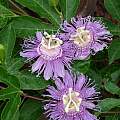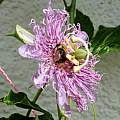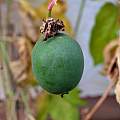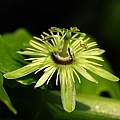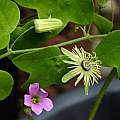Passiflora is the central genus in the family of Passifloraceae. Being known as a genus of (sub-)tropical vines from the Americas, the northernmost species actually rely on underground rhizomes to survive winters at least down to USDA Zone 7.
The name Passiflora follows the interpretation of the flower structure by early colonizing monks symbolizing the passion of Christ: Three stigmas for 3 nails on the cross, 5 anthers symbolizing 5 wounds of Christ, 10 petals for 10 faithful apostles, tendrils and lance-shaped leaves as whips and lances, the instruments of torture and, most prominent, the corona as crown of thorns.
Passiflora incarnata L., sometimes known as Maypop, is native to south-eastern USA, reaching the coldest area of its natural distribution in Illinois, Indiana and Ohio, but has also been introduced to regions of India. It prefers sunny, dry locations, but is rather tolerant of soil conditions. The dark leaved vines can quickly cover 3-5 meters of trellis, climbing with long tendrils which coil up to pull the vine higher. When well established, it may produce expeditious suckers, sending up vines several meters distant from the main plant and can be troublesome under good conditions. Due to the extensive underground spread, Maypop is never really happy in pots, though it will flower. The biggest threat to them are slugs, especially during the late emergence around May. The plants are the exclusive host plant for gulf fritillary butterflies. Reproduction may be carried out by cuttings, by isolating the adventurous roots or through seed, though those germinate rather erratically.
Maypop is a highly useful plant, carrying edible fruit if the self-incompatible flowers are pollinated by a different individual or another member of subgenus Passiflora. Commercially available plants in Europe are often clones of a single plant, so either combine the normal form with the white flowered 'alba' or grow at least one plant from seed. Leaf extracts are used in mild sedatives and anxiolytics. While being very common in Europe (where the advertisements often wrongly feature the more commonly known Passiflora caerulea), the usage in the USA mostly stopped in 1978, when new regulations for medical safety and effectiveness were introduced.
The white and purplish flowers with the wavy corona are somewhat variable even on the same plant. Martin Bohnet speculates the flower color to be dependent on night temperatures, getting darker with colder nights. While a single flower lasts about 2 days, the flowering period goes on for months from late June to mid September. Pollinators are mostly bees and bumblebees, while wasps tend to give more attention to extrafloral nectaries at the leaf axils. Fruits reach the size of a hen egg, start out green but get yellowish as they ripen.
Passiflora lutea L., the yellow Passionflower, is a central North American species spreading from Pennsylvania to Kansas and down to Texas. It prefers moist locations in bright shade or part-day sun. Despite being called "yellow" both in English and Latin, the small (up to 2 cm) but mass-produced flowers rather are a greenish off-white. They are followed by black berries if pollinated, but are (almost) as self sterile as most passion flowers. They belong to subgenus Decaloba and thus are incompatible with the sometimes overlapping Passiflora incarnata.
